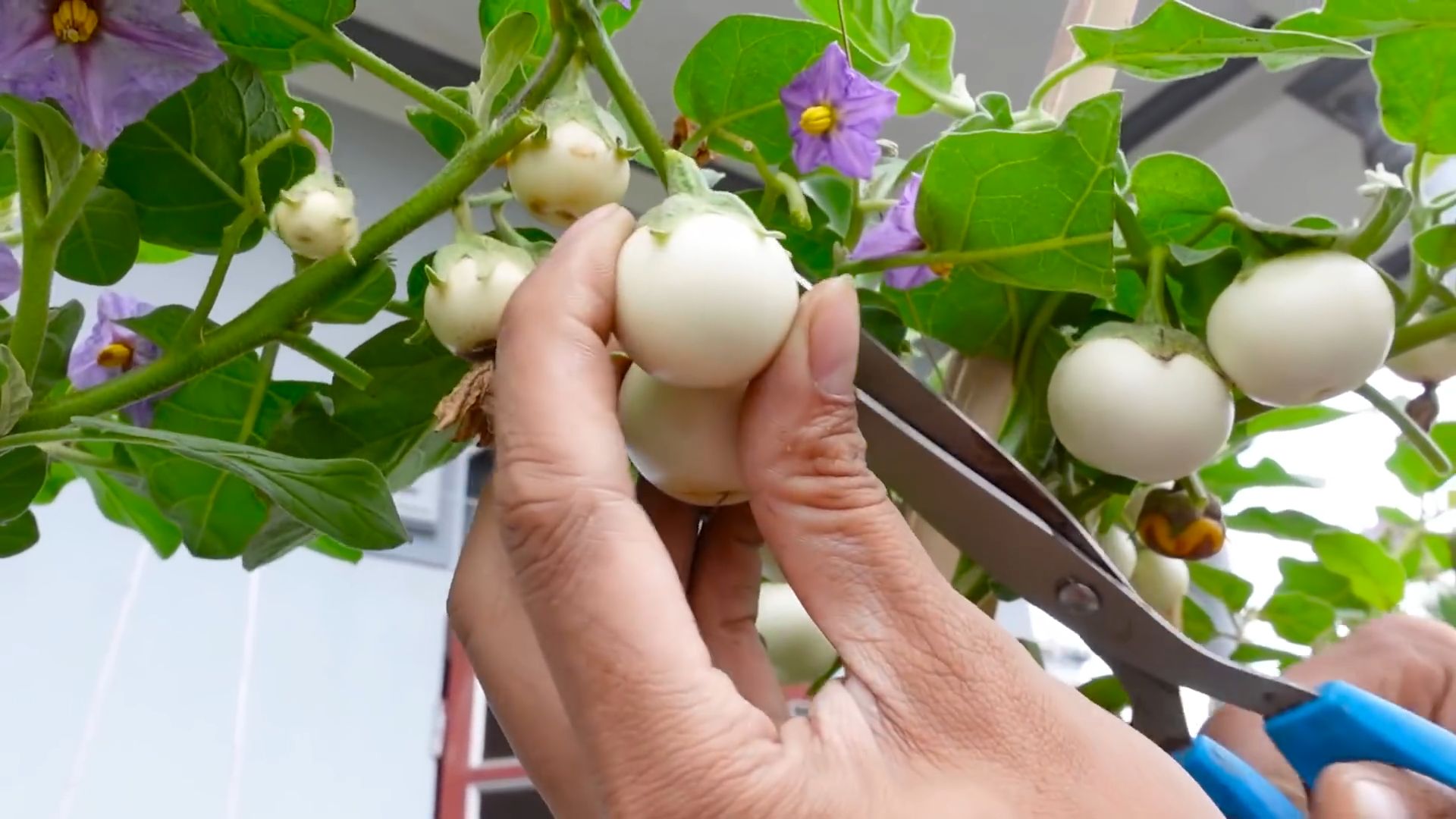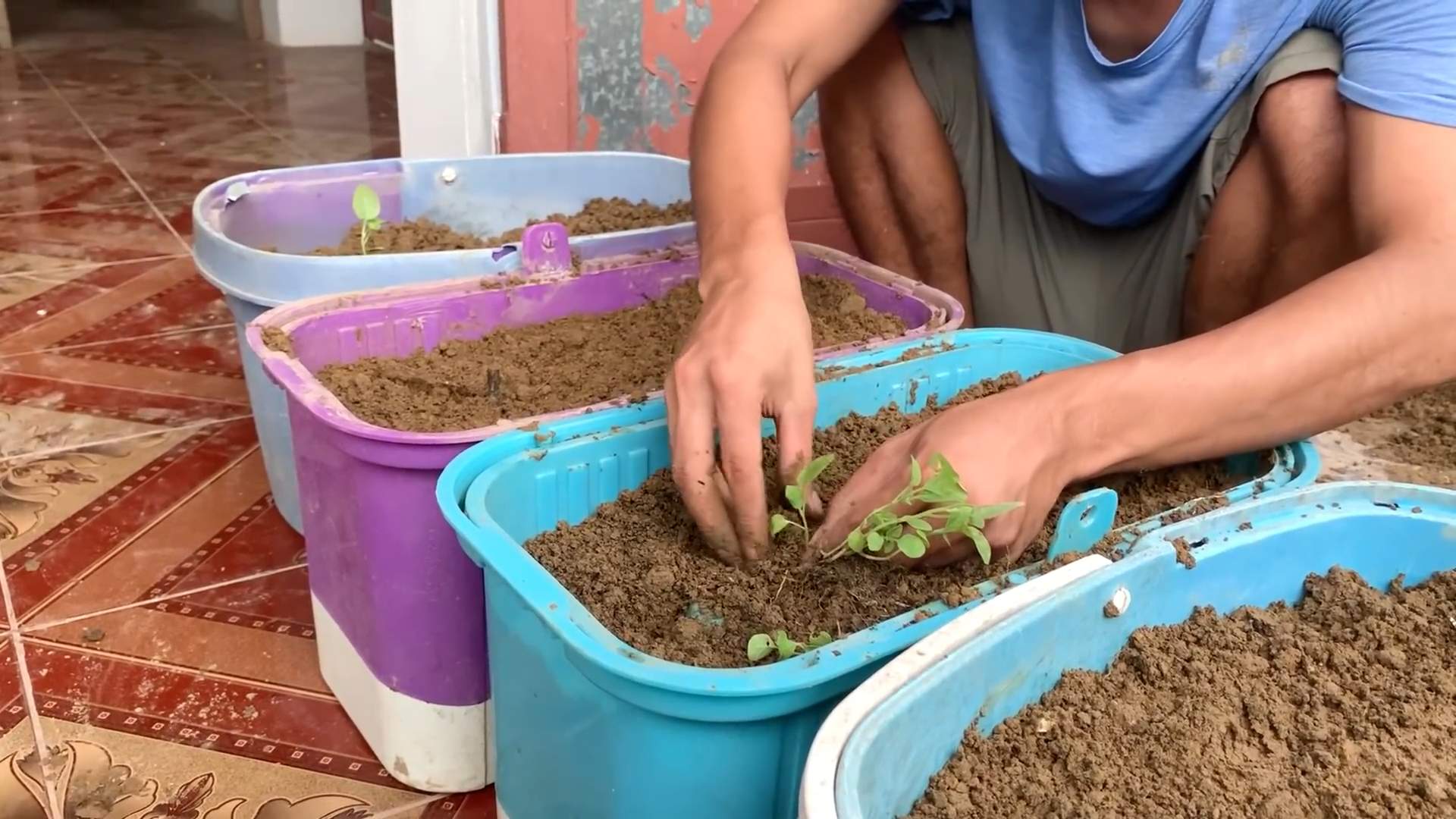White eggplant gardening might sound like an exotic adventure, and honestly, it kind of is! Forget the deep purple you’re used to seeing at the grocery store; we’re diving into the world of creamy, ivory-skinned eggplants that are just as delicious and surprisingly easy to grow at home.
For centuries, eggplants, in all their colorful varieties, have been a staple in cuisines across Asia and the Middle East. While the purple varieties are more common, white eggplants have been cultivated for their unique flavor and texture. Some believe they were among the first varieties grown, prized for their mildness and delicate sweetness.
But why should you bother with white eggplant gardening? Well, for starters, they’re less bitter than their purple cousins, making them perfect for those who find regular eggplants a bit too strong. Plus, growing your own food is incredibly rewarding! Imagine serving up a dish featuring eggplants you nurtured from tiny seedlings. It’s a conversation starter, a source of pride, and a way to connect with nature, all in one.
In this article, I’m going to share some simple DIY tricks and hacks that will help you cultivate a thriving white eggplant garden, even if you’re a complete beginner. From choosing the right seeds to warding off pests naturally, I’ve got you covered. Get ready to impress your friends and family with your homegrown harvest!

Growing White Eggplants: A DIY Guide to a Unique Garden Treat
Okay, so you’re thinking about growing white eggplants? Awesome! They’re not only delicious but also add a really cool, almost ethereal touch to your garden. I’ve grown them myself, and let me tell you, it’s a rewarding experience. This guide will walk you through everything you need to know, from starting seeds to harvesting your ghostly beauties.
Choosing Your White Eggplant Variety
First things first, let’s talk varieties. Not all white eggplants are created equal! Here are a few popular choices:
* ‘Casper’: This is a classic white eggplant. It produces medium-sized, oval-shaped fruits with a mild flavor. It’s a reliable choice and a good starting point for beginners.
* ‘White Beauty’: As the name suggests, this variety is known for its beautiful, pure white skin. The fruits are smaller and rounder than ‘Casper,’ and they have a delicate, slightly sweet taste.
* ‘Gretel’: Part of the “Fairy Tale” series, ‘Gretel’ produces clusters of small, elongated white eggplants. They’re incredibly prolific and perfect for container gardening.
* ‘Listada de Gandia’: While not entirely white, this heirloom variety features stunning white and purple stripes. It’s a real showstopper in the garden and has a rich, flavorful flesh.
I personally love ‘Casper’ for its reliability and ‘White Beauty’ for its delicate flavor. But feel free to experiment and find the variety that suits your taste and growing conditions best!
Starting Your White Eggplant Seeds
Eggplants need a long growing season, so starting them indoors is usually the way to go, especially if you live in a cooler climate. I usually start my seeds about 8-10 weeks before the last expected frost.
Materials You’ll Need:
* White eggplant seeds (obviously!)
* Seed starting trays or small pots
* Seed starting mix (a light, well-draining mix is essential)
* Heat mat (optional, but highly recommended)
* Grow lights (also optional, but they’ll give you stronger seedlings)
* Spray bottle with water
Step-by-Step Instructions:
1. Prepare Your Seed Starting Trays: Fill your seed starting trays or pots with seed starting mix. Gently firm the soil, but don’t pack it down too much.
2. Sow the Seeds: Make a small indentation (about ¼ inch deep) in the center of each cell or pot. Drop one or two seeds into each indentation and cover them lightly with soil.
3. Water Gently: Use a spray bottle to mist the soil thoroughly. You want to moisten the soil without disturbing the seeds.
4. Provide Warmth: Place your seed starting trays on a heat mat. Eggplant seeds need warm soil (around 80-85°F) to germinate successfully. If you don’t have a heat mat, find a warm spot in your house.
5. Provide Light: If you’re using grow lights, position them a few inches above the seed starting trays. If you’re relying on natural light, place the trays in a sunny window.
6. Maintain Moisture: Keep the soil consistently moist, but not soggy. Check the soil daily and mist it with water as needed.
7. Wait for Germination: Eggplant seeds typically germinate in 7-14 days. Be patient!
8. Thin Seedlings (If Necessary): If you planted two seeds per cell or pot and both germinate, thin them out by snipping off the weaker seedling at the soil line. This will give the remaining seedling more room to grow.
9. Harden Off Seedlings: Once your seedlings have developed a few sets of true leaves (the leaves that look like miniature eggplant leaves), it’s time to harden them off. This process gradually acclimates the seedlings to outdoor conditions. Start by placing them outside in a sheltered spot for an hour or two each day, gradually increasing the amount of time they spend outdoors over the course of a week or two.
Preparing Your Garden Bed
While your seedlings are growing indoors, it’s time to prepare your garden bed. Eggplants need full sun (at least 6-8 hours of direct sunlight per day) and well-drained soil.
Soil Preparation:
* Choose a Sunny Location: Select a spot in your garden that receives plenty of sunlight.
* Amend the Soil: Eggplants are heavy feeders, so it’s important to amend the soil with plenty of organic matter. I like to add compost, well-rotted manure, and a balanced organic fertilizer.
* Improve Drainage: If your soil is heavy clay, amend it with sand or perlite to improve drainage. Eggplants don’t like to sit in soggy soil.
* Check the pH: Eggplants prefer a slightly acidic soil pH (around 6.0-6.8). You can test your soil pH with a soil testing kit and amend it accordingly.
Transplanting Your White Eggplant Seedlings
Once the danger of frost has passed and your seedlings are hardened off, it’s time to transplant them into your garden.
Transplanting Instructions:
1. Choose a Cloudy Day: Transplanting on a cloudy day will help reduce stress on the seedlings.
2. Dig Holes: Dig holes that are slightly larger than the root balls of your seedlings. Space the holes about 18-24 inches apart.
3. Remove Seedlings from Pots: Gently remove the seedlings from their pots, being careful not to damage the roots.
4. Plant Seedlings: Place the seedlings in the holes and backfill with soil. Gently firm the soil around the base of the plants.
5. Water Thoroughly: Water the seedlings thoroughly after transplanting.
6. Mulch: Apply a layer of mulch around the base of the plants to help retain moisture, suppress weeds, and regulate soil temperature. I like to use straw or shredded bark.
7. Stake or Cage: White eggplant plants can get quite large and top-heavy, especially when they’re loaded with fruit. It’s a good idea to stake or cage them to provide support.
Caring for Your White Eggplant Plants
Now that your white eggplant plants are in the ground, it’s time to provide them with the care they need to thrive.
Watering:
* Water deeply and regularly, especially during hot, dry weather. Eggplants need consistent moisture to produce abundant fruit.
* Avoid overhead watering, as this can promote fungal diseases. Water at the base of the plants instead.
Fertilizing:
* Fertilize your eggplant plants every 2-3 weeks with a balanced organic fertilizer.
* You can also side-dress the plants with compost or well-rotted manure.
Pest and Disease Control:
* Keep an eye out for common eggplant pests, such as aphids, flea beetles, and spider mites. You can control these pests with insecticidal soap or neem oil.
* Eggplants are also susceptible to fungal diseases, such as early blight and verticillium wilt. To prevent these diseases, provide good air circulation, avoid overhead watering, and mulch around the base of the plants.
Pruning:
* Pruning can help improve air circulation and encourage fruit production.
* Remove any suckers (shoots that grow from the base of the plant) and any yellowing or diseased leaves.
* You can also pinch off the tips of the branches to encourage branching and more fruit production.
Harvesting Your White Eggplants
The moment you’ve been waiting for! White eggplants are typically ready to harvest about 60-80 days after transplanting.
Harvesting Tips:
* Harvest the eggplants when they are firm and glossy. The skin should be smooth and unblemished.
* The size of the eggplant will depend on the variety, but generally, you want to harvest them when they are about two-thirds of their mature size.
* Use a sharp knife or pruning shears to cut the eggplants from the plant, leaving about an inch of stem attached.
* Handle the eggplants carefully, as they can bruise easily.
Storage:
* Store white eggplants in the refrigerator for up to a week.
* Don’t wash them until you’re ready to use them.
Enjoying Your White Eggplants
Now for the best part – eating your homegrown white eggplants! They have a mild, slightly sweet flavor that’s delicious in a variety of dishes.
Cooking Ideas:
* Grilled: Slice the eggplants into rounds and grill them with olive oil, salt, and pepper.
* Roasted: Roast the eggplants with other vegetables, such as tomatoes, peppers, and onions.
* Stuffed: Hollow out the eggplants and stuff them with rice, vegetables, and meat.

Conclusion
So, there you have it! Growing your own white eggplants isn’t just a fun gardening project; it’s a gateway to experiencing a unique flavor profile and adding a touch of elegance to your culinary creations. We’ve explored the ins and outs of cultivating these beautiful vegetables, from seed to harvest, and hopefully, demystified the process along the way.
Why is this DIY trick a must-try? Because it empowers you to control the quality and freshness of your produce. Store-bought eggplants, even the white varieties, often lack the vibrant flavor and delicate texture that homegrown ones possess. Plus, there’s an undeniable satisfaction in nurturing a plant from a tiny seed to a bountiful harvest. Imagine the pride you’ll feel serving a dish featuring eggplants you grew yourself!
Beyond the basic techniques we’ve covered, there’s plenty of room for experimentation. Consider these variations to personalize your white eggplant gardening experience:
* **Container Gardening:** If you’re short on space, white eggplants thrive in large containers. Choose a pot at least 18 inches in diameter and ensure it has excellent drainage. This is a fantastic option for balconies, patios, or even indoor gardening with sufficient sunlight or grow lights.
* **Companion Planting:** Enhance your eggplant’s growth and deter pests by planting beneficial companions like basil, marigolds, or thyme. These herbs not only add beauty to your garden but also attract pollinators and repel unwanted insects.
* **Grafting:** For more advanced gardeners, grafting white eggplant onto a more vigorous rootstock can improve disease resistance and yield. This technique requires some skill but can be well worth the effort.
* **Different Varieties:** Explore the different varieties of white eggplant available. Some are more elongated, while others are rounder. Some have a milder flavor than others. Experiment to find your favorite!
Ultimately, the best way to learn is by doing. Don’t be afraid to get your hands dirty and embrace the challenges and rewards of gardening. Remember to start small, be patient, and observe your plants closely. With a little care and attention, you’ll be harvesting delicious white eggplants in no time.
We are confident that with the right approach, you can successfully grow your own white eggplants. This is more than just a gardening project; it’s an opportunity to connect with nature, learn new skills, and enjoy the fruits (or vegetables!) of your labor.
Now, we want to hear from you! Have you tried growing white eggplants before? What were your experiences? Do you have any tips or tricks to share? We encourage you to try this DIY trick and share your journey with us in the comments below. Let’s build a community of white eggplant enthusiasts and learn from each other. Happy gardening!
Frequently Asked Questions (FAQ)
What are the benefits of growing white eggplants compared to purple eggplants?
White eggplants generally have a milder, less bitter flavor than their purple counterparts. They also tend to have a thinner skin and fewer seeds, making them more pleasant to eat. Some people also find them visually appealing, adding a touch of elegance to dishes. From a gardening perspective, the growing requirements are very similar, so it’s really a matter of personal preference.
How much sunlight do white eggplants need?
White eggplants, like all eggplants, require at least 6-8 hours of direct sunlight per day to thrive. Insufficient sunlight can lead to leggy growth, reduced flowering, and smaller fruit. If you’re growing them indoors, supplement with grow lights to ensure they get enough light.
What kind of soil is best for white eggplants?
White eggplants prefer well-drained, fertile soil with a pH between 6.0 and 6.8. Amend your soil with compost or other organic matter to improve drainage and nutrient content. A slightly acidic soil is ideal for optimal growth.
How often should I water my white eggplant plants?
Water your white eggplant plants deeply and regularly, especially during hot, dry weather. Aim to keep the soil consistently moist but not waterlogged. Check the soil moisture regularly by sticking your finger about an inch deep into the soil. If it feels dry, it’s time to water. Mulching around the plants can help retain moisture and suppress weeds.
When is the best time to plant white eggplants?
The best time to plant white eggplants is after the last frost, when the soil has warmed up to at least 60°F (15°C). You can start seeds indoors 6-8 weeks before the last frost and transplant them outdoors once the weather is suitable. In warmer climates, you can plant directly into the ground.
How do I know when my white eggplants are ready to harvest?
White eggplants are typically ready to harvest when they are firm, glossy, and have reached their mature size (usually around 6-8 inches long, depending on the variety). The skin should be smooth and unblemished. Gently press the skin; if it springs back, it’s ripe. Use a sharp knife or pruning shears to cut the eggplant from the plant, leaving a short stem attached.
What are some common pests and diseases that affect white eggplants?
Common pests that affect white eggplants include aphids, flea beetles, spider mites, and tomato hornworms. Common diseases include verticillium wilt, fusarium wilt, and blossom-end rot. Regularly inspect your plants for signs of pests or diseases and take appropriate action, such as using insecticidal soap, neem oil, or copper fungicide. Ensure good air circulation and avoid overwatering to prevent fungal diseases.
How can I prevent blossom-end rot in my white eggplants?
Blossom-end rot is caused by a calcium deficiency, often due to inconsistent watering. To prevent it, ensure your plants receive consistent moisture and amend your soil with calcium-rich amendments like bone meal or crushed eggshells before planting. You can also use a calcium foliar spray if needed.
Can I grow white eggplants in containers?
Yes, white eggplants can be successfully grown in containers. Choose a large container (at least 18 inches in diameter) with good drainage. Use a high-quality potting mix and provide regular watering and fertilization. Container-grown eggplants may need more frequent watering than those grown in the ground.
What are some good companion plants for white eggplants?
Good companion plants for white eggplants include basil, marigolds, thyme, oregano, and peppers. Basil repels many common eggplant pests, while marigolds attract beneficial insects. Thyme and oregano can help deter flea beetles. Peppers are in the same family as eggplants and can benefit from similar growing conditions.
How do I store harvested white eggplants?
Store harvested white eggplants in the refrigerator for up to a week. Wrap them loosely in plastic wrap or place them in a perforated plastic bag to prevent them from drying out. Avoid storing them near ethylene-producing fruits like apples and bananas, as this can cause them to spoil more quickly.
Can I save seeds from my white eggplants for future planting?
Yes, you can save seeds from your white eggplants, but keep in mind that if you grew a hybrid variety, the seeds may not produce plants that are true to type. To save seeds, allow the eggplant to fully ripen on the plant until it becomes soft and slightly overripe. Scoop out the seeds, rinse them thoroughly, and spread them out to dry on a paper towel. Once they are completely dry, store them in an airtight container in a cool, dark place.
What are some delicious ways to cook with white eggplants?
White eggplants can be used in a variety of dishes, just like purple eggplants. They are delicious grilled, roasted, sautéed, or fried. They can also be used in stews, curries, and dips like baba ghanoush. Their mild flavor makes them a versatile ingredient that pairs well with many different herbs and spices.
How do I get rid of aphids on my white eggplant plants?
Aphids can be controlled with a strong spray of water from a hose. You can also use insecticidal soap or neem oil. Ladybugs are natural predators of aphids, so attracting them to your garden can also help control aphid populations.
My white eggplant leaves are turning yellow. What could be the problem?
Yellowing leaves can be caused by several factors, including nutrient deficiencies, overwatering, underwatering, or pests. Check the soil moisture and ensure your plants are receiving adequate nutrients. Inspect the leaves for signs of pests. If the problem persists, consult a local gardening expert for further assistance.





Leave a Comment